In tech, one of the fundamental ways to become dominant is to make consumers submit to your vision and choose to live within that world. That’s why companies like Apple and Nintendo remain so successful, despite releasing several not-so-well-received products over the years. It’s not just one product that makes you popular, it’s how people believe in the brand and become fans of it.
I see a similar pattern with Carl Pei–led Nothing, which is seeking the kind of validation that made Apple and Nintendo household names – not by following a tried-and-tested formula, but by offering a distinctive take on everyday tech products.
Its Phone (3), perhaps its first true high-end flagship, may tick all the boxes of what a premium smartphone should be, but at its core, it’s a doorway to something more playful. It’s an unusual experience, and sometimes it may or may not make sense, especially with the new Glyph Matrix interface. But that’s exactly what Nothing wants to be: a company known for doing the unexpected and embracing the strange.
In fact, if I am honest, it feels refreshing and welcoming. And it’s okay if the Nothing Phone (3) isn’t the most spec-heavy smartphone – it has Nothing’s own quirkiness through and through. But this time, the ambitions are grand and so is the sticker price. The real question is: does the Phone (3), as baffling and fascinating as it might be, make sense to you?
What: Nothing Phone (3)| Price: Rs 80,000
Polarising design
Pick any Nothing device, and there’s a distinct dystopian aesthetic to it. I am glad the company is comfortable with its design choices and isn’t afraid to express itself. The Phone (3) follows the same path though this time everything feels more polished. The see-through transparent glass back gives the device that signature Nothing feel. The back features a grid pattern, showcasing three printed circuit boards, along with visible screws, circles, and cutouts that give off the vibe of a tech product, not just another smartphone.
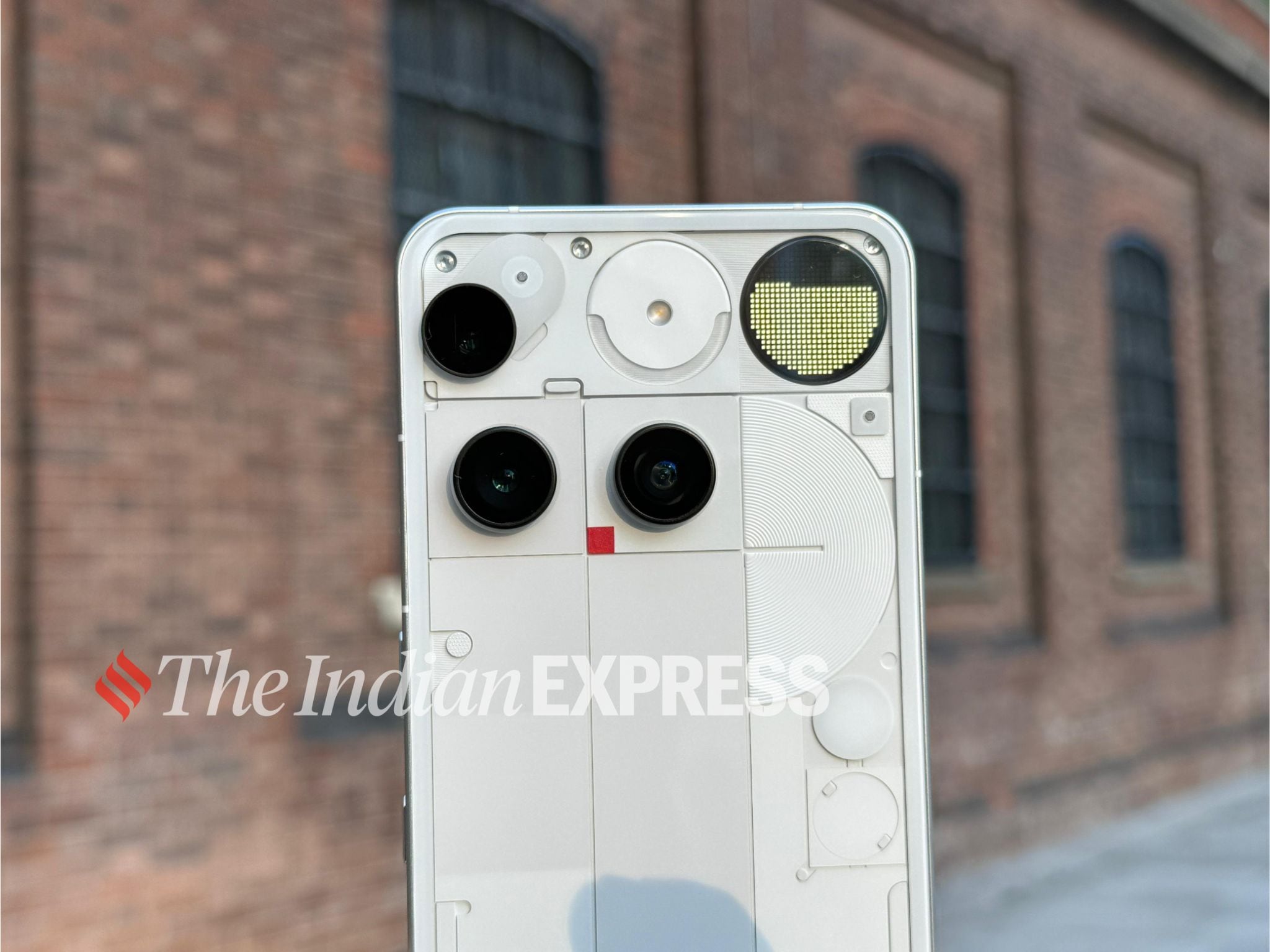 I really liked how the Phone (3) looks. (Image credit: Anuj Bhatia/Indian Express)
I really liked how the Phone (3) looks. (Image credit: Anuj Bhatia/Indian Express)
The cameras, meanwhile, have a rather unusual layout. The three sensors are positioned within specific squares in a separated arrangement: two are lined up next to each other, while the third sits in a corner of the phone, not really aligned with anything else. It feels absolutely wild every time I see the Phone (3).
There’s something undeniably charming about the Phone (3), with its retro-chic aesthetic. The hipster-friendly, old-school design may be polarising to some, but I kind of enjoy the goofiness and the disturbingly weird vibe at the same time. And honestly, that’s okay, as long as you are the right audience for it.
Story continues below this ad
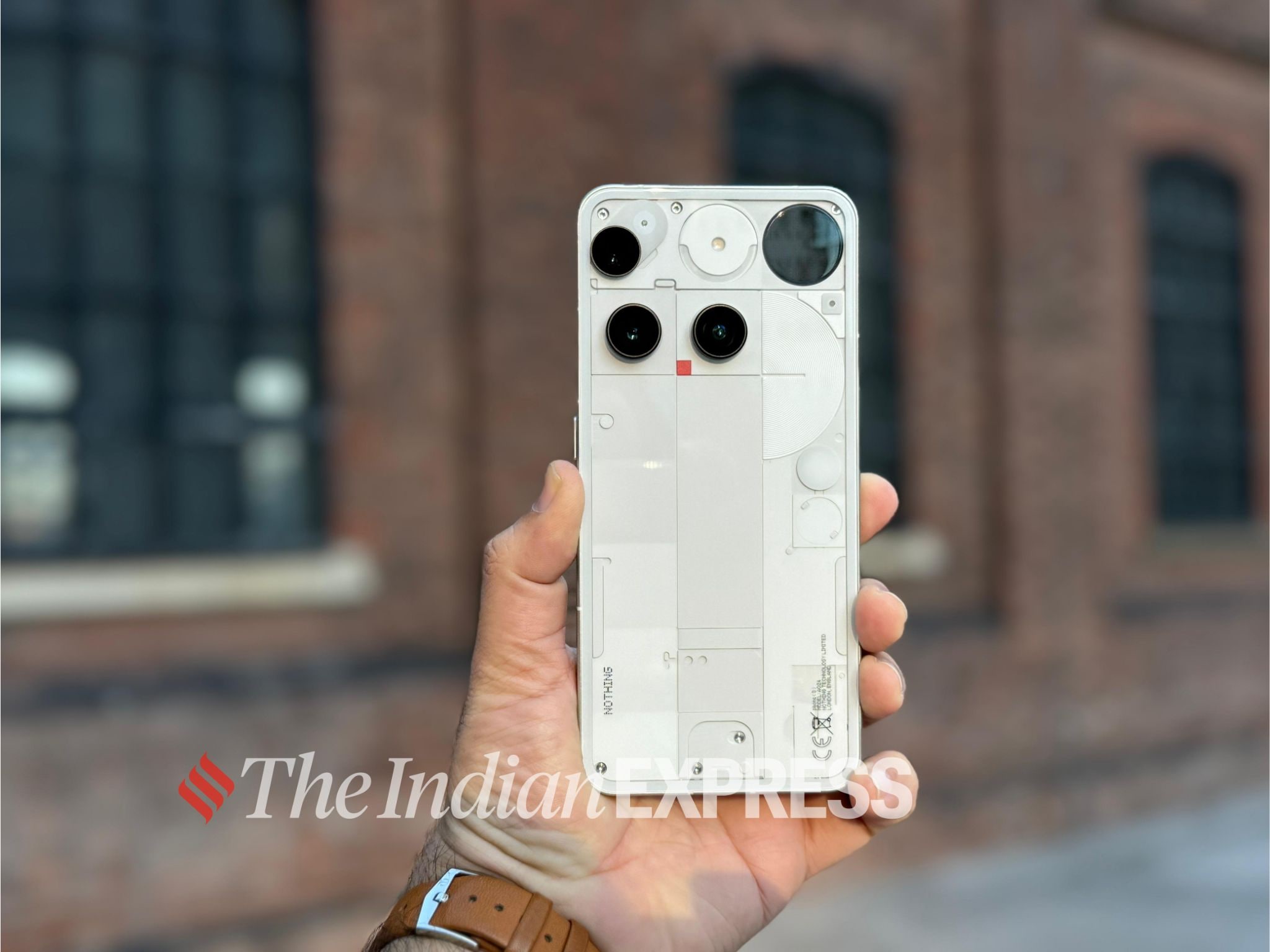 The camera’s layout has shifted from the camera bump to a triple-rear camera, which sees two sensors sat below a third, all out of alignment. (Image credit: Anuj Bhatia/Indian Express)
The camera’s layout has shifted from the camera bump to a triple-rear camera, which sees two sensors sat below a third, all out of alignment. (Image credit: Anuj Bhatia/Indian Express)
The Phone (3) looks beautiful and feels great in the hand. I love holding it in a way I haven’t since the iPhone X. It comes in black and white, and the white version, which I have for review, reminds me of the original iPod. The device features an aluminum and glass sandwich design and weighs 218 grams. The Phone (3) also supports the standard IP68 water and dust resistance.
The Glyph Matrix interface
For me, the most eye-catching feature of the Phone (3) is a small dot-matrix screen on the top-right corner of the device that powers the Glyph Matrix interface; and it’s a nifty experience. At times, it feels a bit gimmicky, but there’s a certain thrill to it. And because it’s a physical hardware feature (reminding me of the crank on the Playdate console), the interaction feels natural.
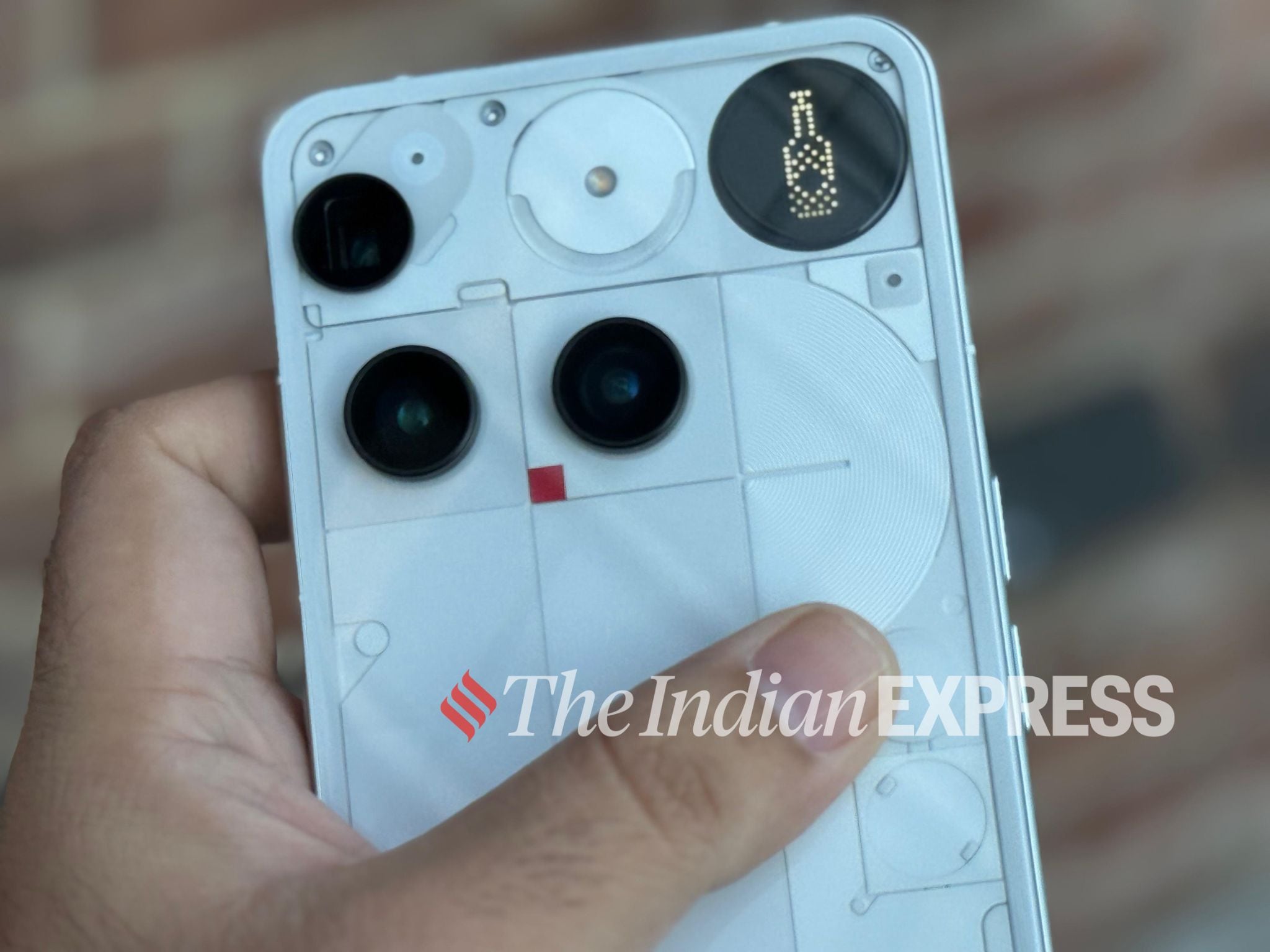 Glyph Matrix offers an interactive option for users looking to get quick updates without using the main display. (Image credit: Anuj Bhatia/Indian Express)
Glyph Matrix offers an interactive option for users looking to get quick updates without using the main display. (Image credit: Anuj Bhatia/Indian Express)
With the Phone (3), Nothing has done away with the signature “Glyph” LED strips on the back, the ones that used to light up in complex patterns for notifications, calls, timers, and charging, a staple of its earlier smartphones. In their place is the new Glyph Matrix interface. The idea remains the same: to notify users about things like messages and calls. But this time, since it’s a real display, it’s more functional. However, unlike many others who have tried (and failed) to integrate secondary displays, Nothing opted for a dot-matrix screen, the kind you often see on buses and at airports displaying important information. The matrix is made up of 489 LEDs and can display monochromatic images.
Well, the Glyph Matrix showcases Glyph “Toys,” as Nothing calls them. Right now, there are a handful of Glyph Toys. Some are simple widgets, like a battery level indicator or a stopwatch. But my favourites are still the games, like Spin the Bottle, Rock, Paper, Scissors, and the Magic 8 Ball. One Glyph Toy that felt silly but fun to me is the one that lets you take photos and turn them into Glyph patterns. It reminded me of how Nintendo made a camera for the Game Boy that let you take photos and convert them into monochrome images. I am hoping to see more Glyph Toys in the future, as Nothing is making it easy to make your own Glyph Toys via an SDK.
Story continues below this ad
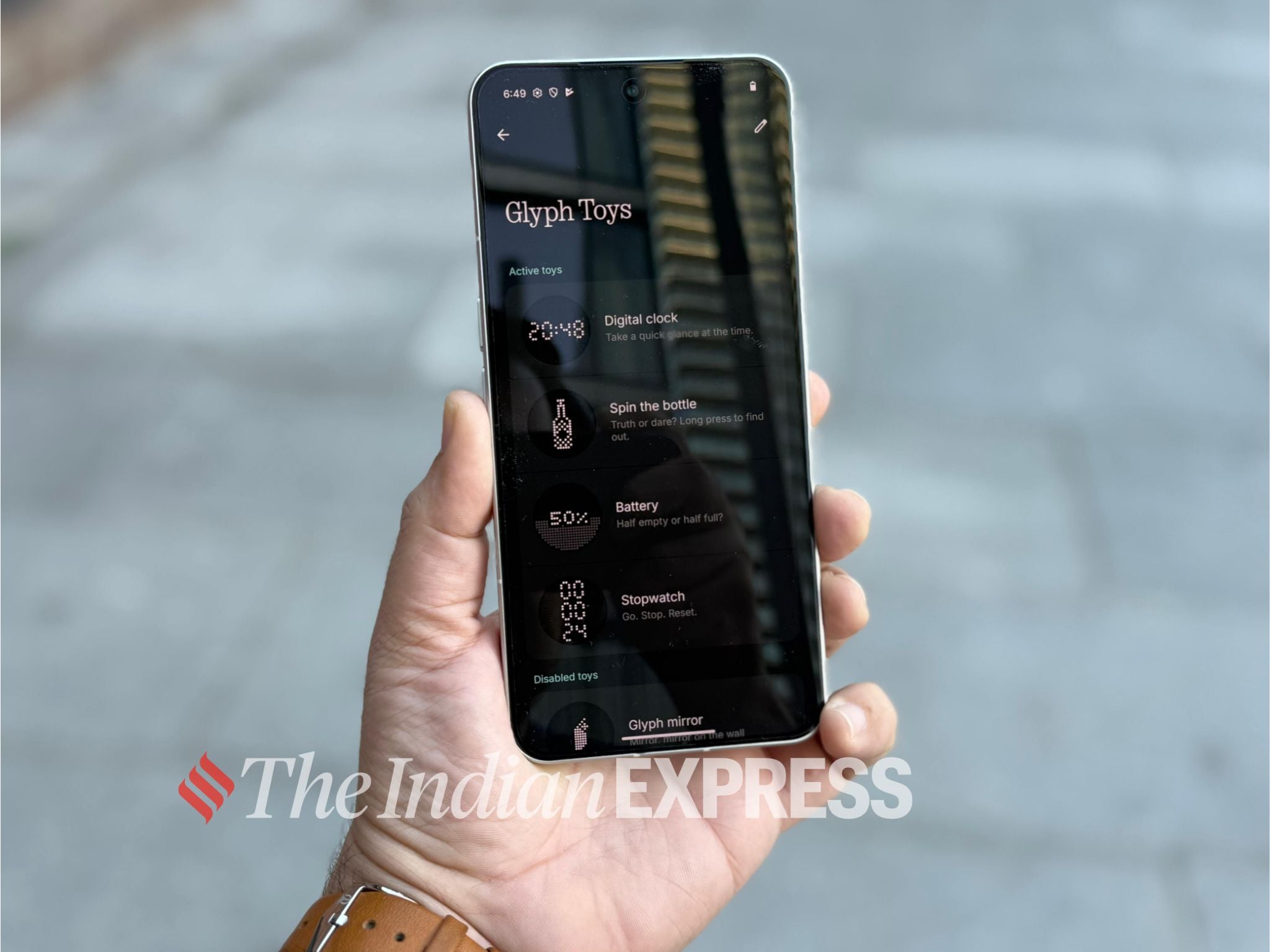 Glyph Matrix is a disc made up of 489 LEDs found at the rear of the device. (Image credit: Anuj Bhatia/Indian Express)
Glyph Matrix is a disc made up of 489 LEDs found at the rear of the device. (Image credit: Anuj Bhatia/Indian Express)
I think the idea of a dot-matrix display is really fun, even if it may feel a bit silly at times. But that’s exactly what makes the Phone (3) stand out from other smartphones. I also liked how you interact with the matrix through the Glyph button, which is built into the rear of the Phone (3). It’s a single button that, when pressed, activates the Glyph Matrix, allowing you to cycle through different Toys, with a long press used to activate them. The interaction is simple and intuitive, though I do wish there was some form of tactile feedback.
In the Settings menu, you can customise the Glyph Matrix to your liking. A standout feature of the dot-matrix display is how neatly it handles notifications. You can choose to be notified about specific alerts from select apps and even set custom display artwork to appear on the Glyph Matrix, making it easier to recognise what the notification is about at a glance. I also like this notification approach because I don’t have to open the phone every time a notification comes in. It’s a better way to avoid the madness and anxiety that constant notifications can cause, especially when you don’t want to be glued to your phone.
Fine-tuned hardware and software
The Phone (3) has a 6.7-inch screen size; it’s a large, fast OLED display that supports a 120Hz refresh rate and reaches up to 1600 nits at maximum brightness, peaking at 4,500 nits with compatible HDR content, which looks really good.
The Phone (3) is powered by a Snapdragon 8s Gen 4 processor, which is fast but not quite flagship-grade. Nothing is very clear that it’s not chasing the spec game with the Phone (3), and I think that makes sense, the longevity of the chip matters most, especially since smartphones these days receive software updates for years. In my time testing the Phone (3), the device felt snappy, and apps opened quickly with no noticeable lag. My review unit is a premium unit with 16GB RAM and 512GB of storage.
Story continues below this ad
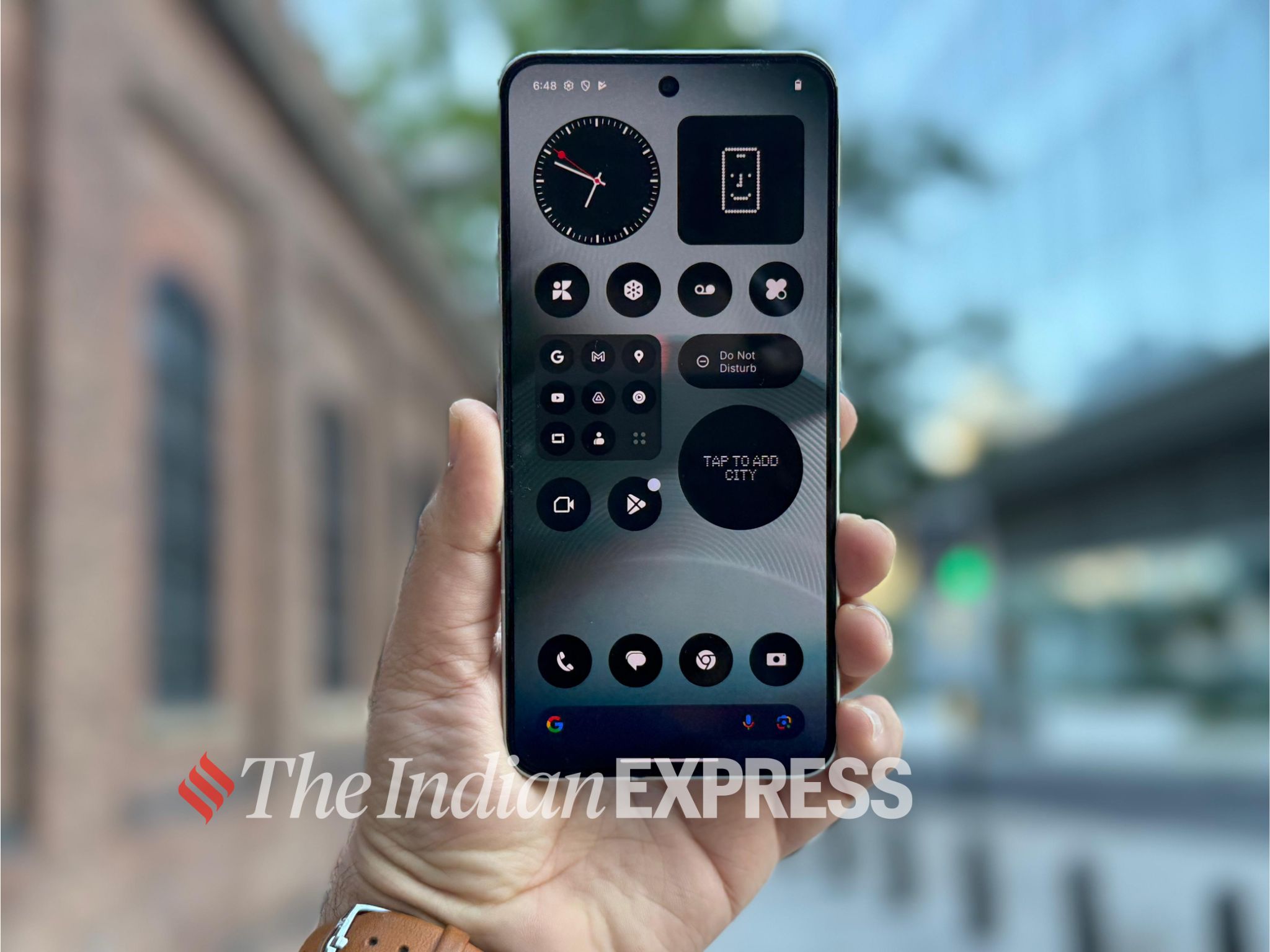 Nothing Phone (3) ships with Android 15, with the custom Nothing OS 3.5 interface on top. (Image credit: Anuj Bhatia/Indian Express)
Nothing Phone (3) ships with Android 15, with the custom Nothing OS 3.5 interface on top. (Image credit: Anuj Bhatia/Indian Express)
The battery life is great: the Phone (3) ships with a 5,150 mAh battery that lasts about two days between charges, even with a mix of 5G and Wi-Fi usage. A compatible 65W wired charger is supported. There’s also 15W wireless charging, if you care about it.
The Phone (3) runs Nothing’s version of Android 15, which offers a relatively clean, fast, and unique experience, thanks to subtle design touches based around dot-matrix art. The design language Nothing has used for the user interface is interesting, and the wide range of customisation options makes the interaction a lot more fun. I particularly enjoyed the monochrome, distraction-free themes. As for updates, Nothing’s software policy still doesn’t match the likes of Google Pixel devices or Samsung Galaxy smartphones, but it’s getting close, with the company promising five Android OS upgrades and 7 years of security updates.
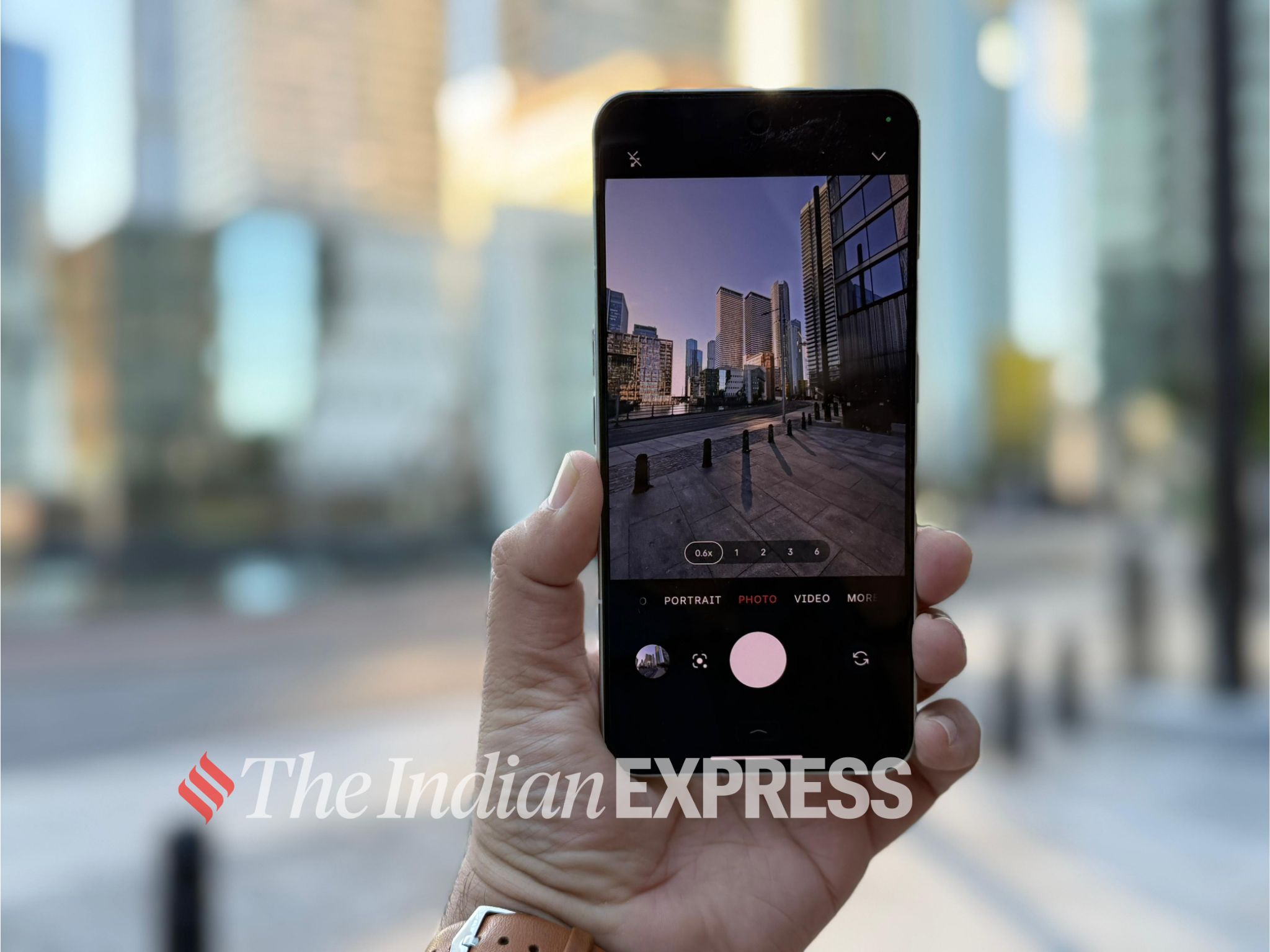 Nothing Phone (3) feels great in hand. (Image credit: Anuj Bhatia/Indian Express)
Nothing Phone (3) feels great in hand. (Image credit: Anuj Bhatia/Indian Express)
A major software addition to the Phone (3) is Nothing’s Essential Space app, which leans heavily on AI. The app essentially collects and analyses various screenshots, text, and voice notes. A dedicated button on the side of the phone captures what’s on screen, while pressing and holding it records a quick voice note to go along with it. The app then analyses the content to generate summaries, transcriptions, and possible actions such as reminders or to-do lists. Right now, the app is fairly basic, to say the least. Some features, like AI summaries, are hit-or-miss, but others, like Essential Search, show great potential.
Improved cameras
The Phone (3) has three cameras on the back: a 50MP main camera with an f/1.68 aperture, a 50MP ultra-wide camera with a 114-degree field of view, and a 50MP periscope lens offering up to 3x optical zoom, 6x digital zoom, and 60x AI Super Res Zoom. This will also serve as a macro camera, allowing for clearer close-up shots. The front-facing camera is also 50MP.
Story continues below this ad
 Nothing Phone 3 camera samples. Image resized for web
Nothing Phone 3 camera samples. Image resized for web
 Nothing Phone 3 camera samples. Image resized for web
Nothing Phone 3 camera samples. Image resized for web
 Nothing Phone 3 camera samples. Image resized for web
Nothing Phone 3 camera samples. Image resized for web
 Nothing Phone 3 camera samples. Image resized for web
Nothing Phone 3 camera samples. Image resized for web
 Nothing Phone 3 camera samples. Image resized for web
Nothing Phone 3 camera samples. Image resized for web
 Nothing Phone 3 camera samples. Image resized for web
Nothing Phone 3 camera samples. Image resized for web
Photos taken with the Phone (3)’s main camera look good, delivering fine detail and solid dynamic range. I think it performs well in most situations, though low-light performance isn’t its strong suit. The ultrawide camera is reasonably good, while the 3x zoom camera is arguably the best of the three. I wouldn’t say the Phone (3) beats the top smartphone cameras on the market, but it’s remarkably good, especially the 3x zoom, which lets you get incredibly close to subjects while capturing plenty of detail. It’s a great option if you enjoy taking macro-style shots.
Should you buy the Nothing Phone (3)?
The Phone (3) has more power than I know what to do with. That’s the premise Nothing is going for with its first and most expensive smartphone. It’s right there, but not quite in the same league as the highest-end options from Apple, Samsung, or Google. In fact, it’s the opposite, and that’s refreshing. It’s a smartphone that goes back to the basics, while still offering a sense of premiumness.
The Phone (3) is a forward-looking device, and I admire it for its design and the unique dot-matrix display. At the same time, it’s a fascinating puzzle… one that takes some time to figure out. On the surface, Nothing’s new high-end smartphone feels deeply nostalgic, rooted in the idea of building a legacy in the way Apple and Nintendo have done. There’s a far more interesting device hidden in here, an experience that, at its best, has a sense of humour, if you can understand and relate to it.

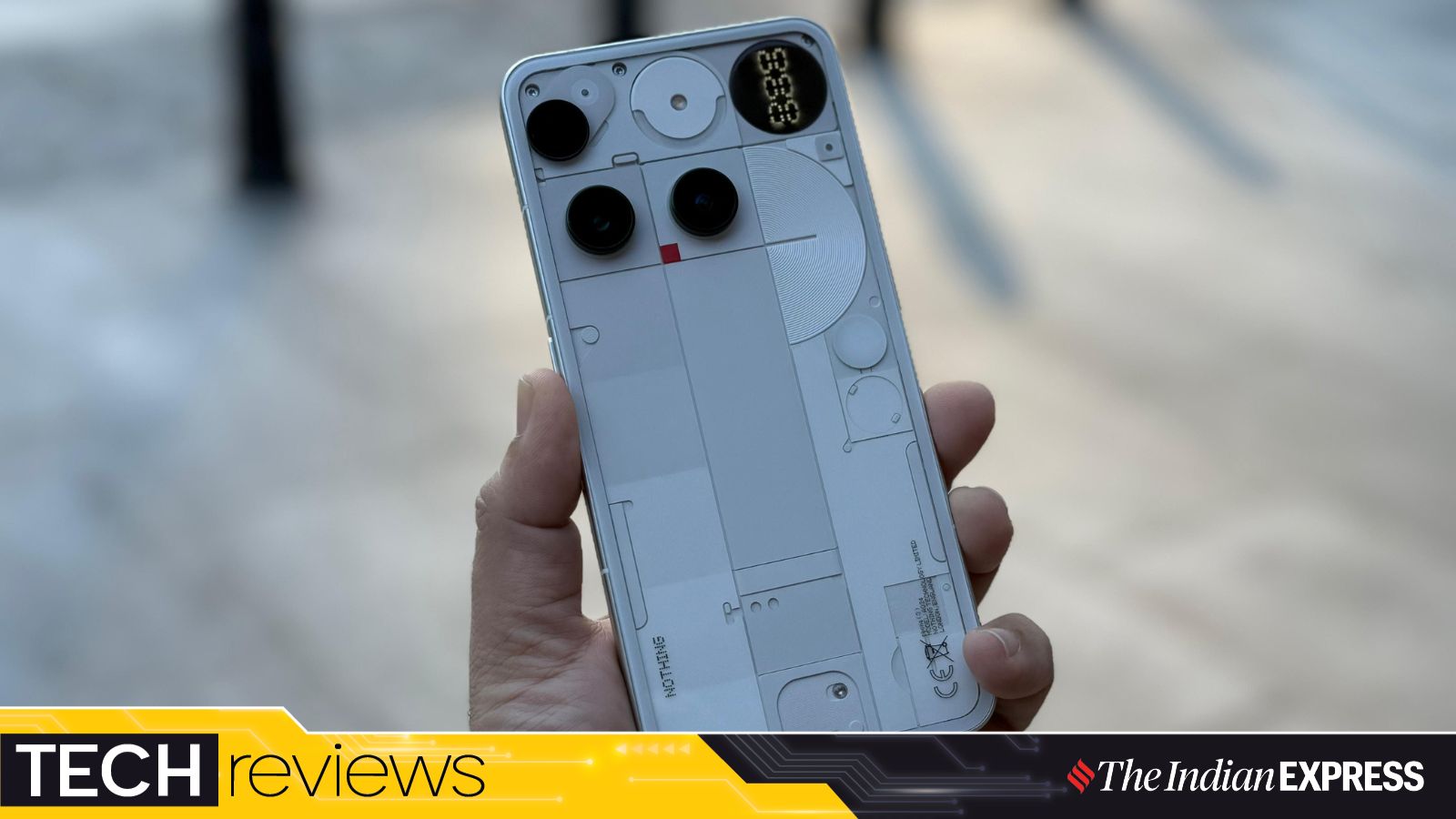

Average Rating